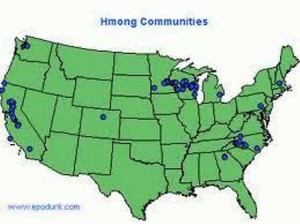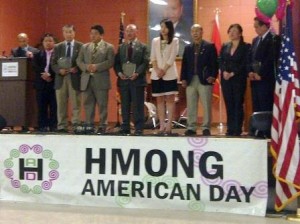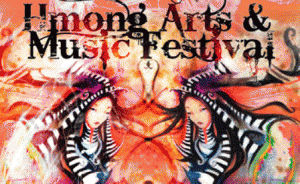» posted on Wednesday, July 17th, 2013 by Linda Lou Burton
Hmong Americans
 Linda Burton posting from Saint Paul, Minnesota –Saint Paul’s population is 15% Asian, third highest Asian population in the list of capital cities. That’s according to the 2010 US Census, which also denotes specific ethnicity; it tells us that 260,073 people of Hmong descent live in the United States, with the largest Hmong American community right here in Saint Paul. The United States opened its doors to Hmong war refugees with the Refugee Assistance Act of 1975 following the communist takeover of Laos; more than 18,000 Hmong had died in support of US forces during the Vietnam conflict. By 1978 about 30,000 Hmong had immigrated; primarily men directly associated with the war efforts. When the Refugee Act of 1980 was passed, families
Linda Burton posting from Saint Paul, Minnesota –Saint Paul’s population is 15% Asian, third highest Asian population in the list of capital cities. That’s according to the 2010 US Census, which also denotes specific ethnicity; it tells us that 260,073 people of Hmong descent live in the United States, with the largest Hmong American community right here in Saint Paul. The United States opened its doors to Hmong war refugees with the Refugee Assistance Act of 1975 following the communist takeover of Laos; more than 18,000 Hmong had died in support of US forces during the Vietnam conflict. By 1978 about 30,000 Hmong had immigrated; primarily men directly associated with the war efforts. When the Refugee Act of 1980 was passed, families  were permitted to come. Political controversy surrounded the remaining Hmong refugees after the 1980 immigration wave – should they be repatriated, allowed to immigrate, or left in the refugee camps in Thailand? Eventually tens of thousands of Thai-based Hmong refugees were granted US immigration rights, leading to highly emotional reunions of long-separated Hmong families. As of the 2010 US Census, the largest Hmong American populations were in California, Minnesota, Wisconsin, North Carolina, and Michigan, with the Saint Paul metro area being home to the largest group. It is a strong and tightly woven community, as immigrants adapt to American culture while still maintaining their homeland
were permitted to come. Political controversy surrounded the remaining Hmong refugees after the 1980 immigration wave – should they be repatriated, allowed to immigrate, or left in the refugee camps in Thailand? Eventually tens of thousands of Thai-based Hmong refugees were granted US immigration rights, leading to highly emotional reunions of long-separated Hmong families. As of the 2010 US Census, the largest Hmong American populations were in California, Minnesota, Wisconsin, North Carolina, and Michigan, with the Saint Paul metro area being home to the largest group. It is a strong and tightly woven community, as immigrants adapt to American culture while still maintaining their homeland  roots. Organizations in Saint Paul that serve the Hmong community are the Hmong American Partnership, founded in 1990 to help Hmong refugees adjust to life in America; the Hmong Cultural Center, founded in 1992 to enhance cross-cultural awareness; and the Hmong Archives, founded in 1999 to collect and preserve Hmong heritage. And the Hmong Village on Johnson Boulevard is a favored destination for any resident of Saint Paul who loves papaya salad, or Pho.
roots. Organizations in Saint Paul that serve the Hmong community are the Hmong American Partnership, founded in 1990 to help Hmong refugees adjust to life in America; the Hmong Cultural Center, founded in 1992 to enhance cross-cultural awareness; and the Hmong Archives, founded in 1999 to collect and preserve Hmong heritage. And the Hmong Village on Johnson Boulevard is a favored destination for any resident of Saint Paul who loves papaya salad, or Pho.
About the Hmong American Partnership (HAP), which was founded to help Hmong refugees adjust to life in America by drawing on the strengths of both Hmong and American cultures. Christopher Thao and Robert Anderson shared a vision of an organization that would help newly arrived Hmong refugees adjust to life in the United States. Initially, HAP focused on providing basic social services to new arrivals, such as helping Hmong refugees receive public assistance benefits, teaching English classes, and helping Hmong families transition into American society.
As the Saint Paul-Minneapolis area became home to the largest concentration of Hmong people in the United States, HAP also grew into one of the biggest nonprofit Hmong organizations in the US. The growth in the size and service offerings of HAP over the years has been dramatic – at first only two programs were offered; the operating budget was $400,000. Currently HAP offers over 20 programs with an organizational budget of more than $3 million. HAP has grown from a provider of refugee-resettlement assistance to an established nonprofit social services and community development provider. The four main service areas are Education and Training, Elderly Services, Employment Services, and Youth and Family Services. Bao Vang is President/CEO of the organization; Board Chair is Chue Vue, Partner at United Legal Associates; Board Vice Chair is Gary Kwong, Retired 3M Research Chemist ; Secretary is Tom Thao, Data Manager College of Design, University of Minnesota.
Hmong American Partnership http://www.hmong.org/
 About the Hmong Cultural Center, well-known in the community for its long-running Citizenship, ESL, Qeej, Dance, Marriage and Funeral Song Instruction Classes. It is the primary Hmong and Asian American organization in the area that provides community outreach activities related to multicultural education for the purposes of promoting positive race relations. The Resource Center Library is the site of the most comprehensive collection of Hmong-related literature, scholarly research, and multimedia materials in North America; it partners with the Hmong Studies Journal, the only peer-reviewed scholarly journal devoted to Hmong Studies, to disseminate research related to Hmong Americans and the Hmong Diaspora in Asia and around the world. The Center also partners with the Hmong Archives on HmongEmbroidery.org, the first virtual Hmong textiles museum; and hosts LearnaboutHmong.net, a multimedia arts education website for teaching Hmong history, culture and folk arts. Executive Director of the Center is Txongpao Lee.
About the Hmong Cultural Center, well-known in the community for its long-running Citizenship, ESL, Qeej, Dance, Marriage and Funeral Song Instruction Classes. It is the primary Hmong and Asian American organization in the area that provides community outreach activities related to multicultural education for the purposes of promoting positive race relations. The Resource Center Library is the site of the most comprehensive collection of Hmong-related literature, scholarly research, and multimedia materials in North America; it partners with the Hmong Studies Journal, the only peer-reviewed scholarly journal devoted to Hmong Studies, to disseminate research related to Hmong Americans and the Hmong Diaspora in Asia and around the world. The Center also partners with the Hmong Archives on HmongEmbroidery.org, the first virtual Hmong textiles museum; and hosts LearnaboutHmong.net, a multimedia arts education website for teaching Hmong history, culture and folk arts. Executive Director of the Center is Txongpao Lee.
Hmong Cultural Center http://www.hmongcc.org/
 About the Hmong Archives; founded by Marlin LeRoy Heise (Minnesota Historical Society retiree), Yuepheng Xiong (founder of Hmong ABC), Tzianeng Vang (founder of Hmong Professional Network) and other Hmong professionals, with the mission of researching, collecting, preserving, interpreting, and disseminating materials in all formats about or by Hmong. “Collecting and Preserving Hmong Heritage Is A Thing of The Future” is their tagline; believing that preservation of Hmong heritage is an important aspect in the Hmong community. “Ten years from now, the younger Hmong generations will no longer remember the experiences of the Hmong in the Vietnam War era. Already, many Hmong kids have a lack of knowledge as to why their parents came to the United States and the series of tragic events that took place in Laos to cause such a migration.”
About the Hmong Archives; founded by Marlin LeRoy Heise (Minnesota Historical Society retiree), Yuepheng Xiong (founder of Hmong ABC), Tzianeng Vang (founder of Hmong Professional Network) and other Hmong professionals, with the mission of researching, collecting, preserving, interpreting, and disseminating materials in all formats about or by Hmong. “Collecting and Preserving Hmong Heritage Is A Thing of The Future” is their tagline; believing that preservation of Hmong heritage is an important aspect in the Hmong community. “Ten years from now, the younger Hmong generations will no longer remember the experiences of the Hmong in the Vietnam War era. Already, many Hmong kids have a lack of knowledge as to why their parents came to the United States and the series of tragic events that took place in Laos to cause such a migration.”
 Collections in the Archives: audio cassettes, CDs and records; books in over a dozen Hmong scripts and two dozen languages; files and boxes of brochures, pamphlets and newspaper articles about or by Hmong; maps of various parts of the Hmong world, past and present; object collections of Hmong cultural artifacts such as baskets, musical instruments, cross-bows, batik tools, and costumes; photographs, especially from the 1980s and 1990s; posters of ads for Hmong concerts, CDs, videos and events; video collections of Hmong music, fiction and documentaries; newspapers and periodicals; Hmong artists’ depictions of people and life in paintings, drawings, and sculptures. As of March 2013, more than 150,000 items had been accessioned.
Collections in the Archives: audio cassettes, CDs and records; books in over a dozen Hmong scripts and two dozen languages; files and boxes of brochures, pamphlets and newspaper articles about or by Hmong; maps of various parts of the Hmong world, past and present; object collections of Hmong cultural artifacts such as baskets, musical instruments, cross-bows, batik tools, and costumes; photographs, especially from the 1980s and 1990s; posters of ads for Hmong concerts, CDs, videos and events; video collections of Hmong music, fiction and documentaries; newspapers and periodicals; Hmong artists’ depictions of people and life in paintings, drawings, and sculptures. As of March 2013, more than 150,000 items had been accessioned.
Hmong Archives http://www.hmongarchives.org/
 About the Hmong Village; it’s a fun place to go; a former warehouse, filled with vibrant color, smells, and sounds. There is traditional clothing for sale, or you can buy shoes, or pots and pans. There are at least a dozen DVD movie stalls; most have several screens playing different Asian movies. Get a haircut or go to the grocery; buy bright-orange persimmons and other fresh produce at the farmers market, where the walls are hand-painted with murals of home. But what really makes Hmong Village a destination spot is the food. At least 17 restaurants serve piping hot bowls of Pho; get curry noodles, roasted chicken legs, barbecue ribs, and freshly-made green papaya salad. At Mai’s Deli she always asks “How hot?” 1 Pepper, 2 Peppers, 3? There are tea houses and bubble tea vendors; a bakery serving croissants, and some very non-Hmong pizza by the slice.
About the Hmong Village; it’s a fun place to go; a former warehouse, filled with vibrant color, smells, and sounds. There is traditional clothing for sale, or you can buy shoes, or pots and pans. There are at least a dozen DVD movie stalls; most have several screens playing different Asian movies. Get a haircut or go to the grocery; buy bright-orange persimmons and other fresh produce at the farmers market, where the walls are hand-painted with murals of home. But what really makes Hmong Village a destination spot is the food. At least 17 restaurants serve piping hot bowls of Pho; get curry noodles, roasted chicken legs, barbecue ribs, and freshly-made green papaya salad. At Mai’s Deli she always asks “How hot?” 1 Pepper, 2 Peppers, 3? There are tea houses and bubble tea vendors; a bakery serving croissants, and some very non-Hmong pizza by the slice.
Hmong Village, 1001 Johnson Boulevard

